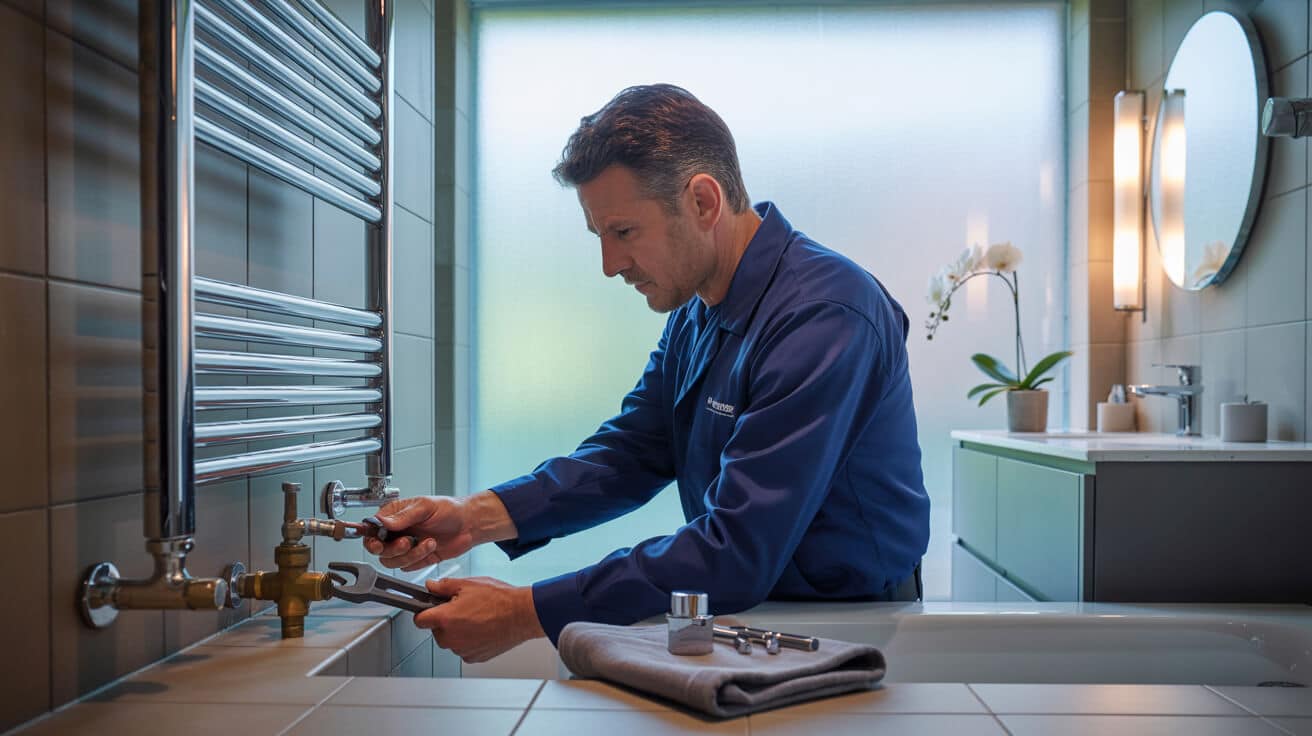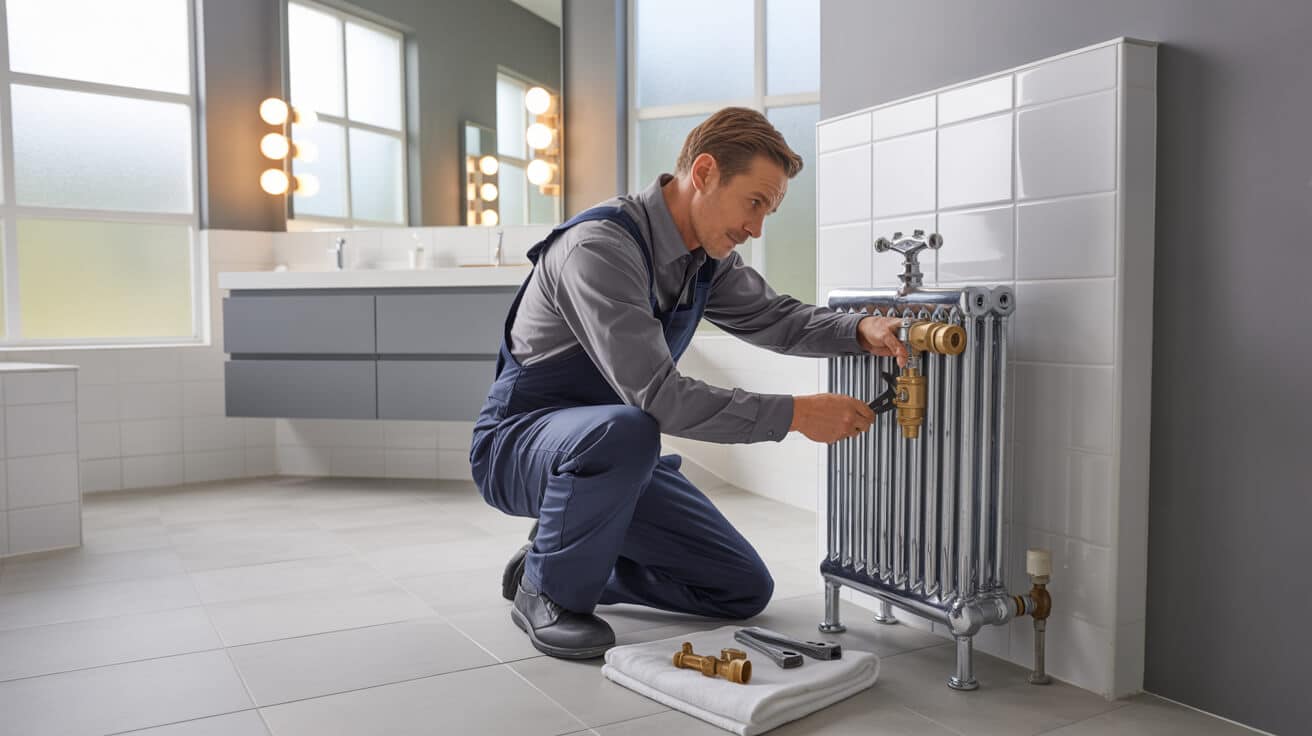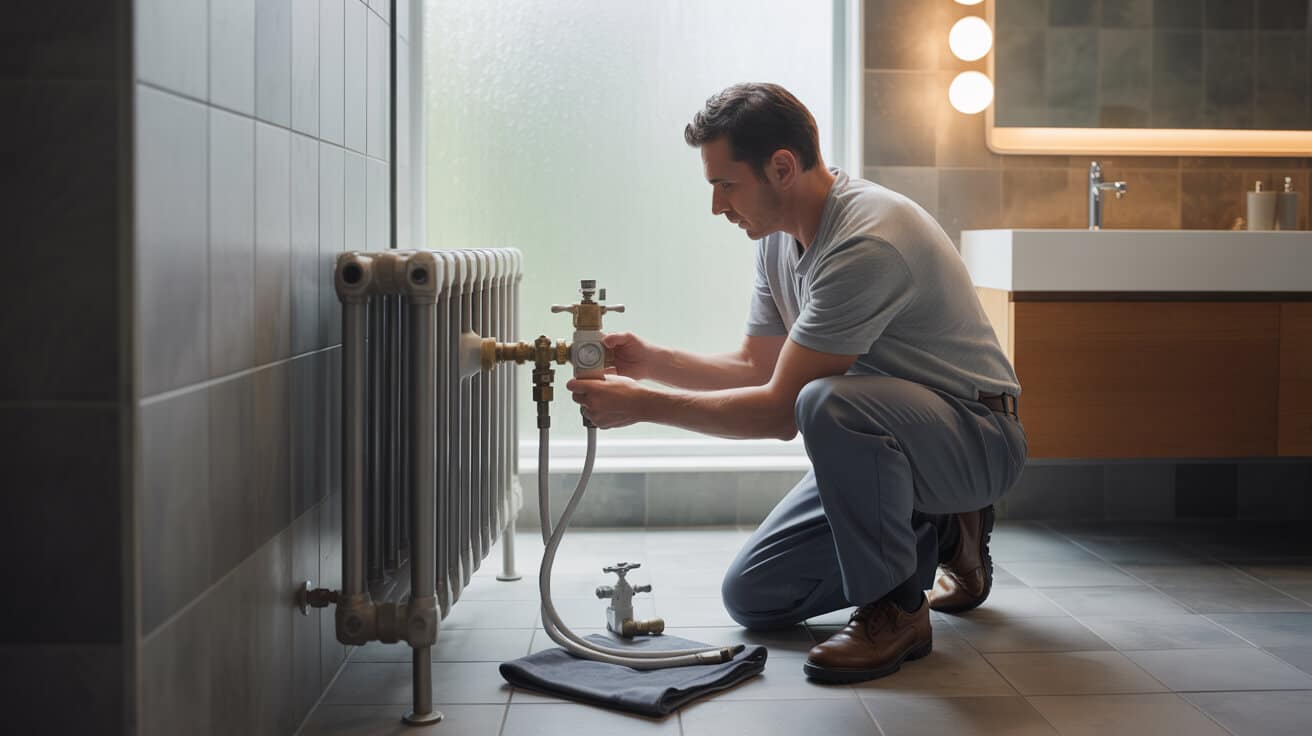Heating valve renewal encompasses the professional diagnosis, removal, and incorporation of updated flow control components at critical junctures in water-based heating systems. These systems, found in domestic dwellings, rental portfolios, managed estates, and commercial buildings, depend on specialised valves—such as thermostatic, manual, or zone variants—to regulate and direct heated water. A planned or urgent replacement can safeguard both infrastructure and occupant welfare, preventing property damage while ensuring uninterrupted comfort and regulatory alignment. Obsolete valves, if neglected, may compromise your property’s safety, energy ratings, and long-term maintenance costs, revealing the silent significance of robust, future-facing plumbing strategy.
Etymology or Name Origin
The word “valve” originates from the Latin valva, referring to a folding door, the etymological frame through which fluid circuit regulation entered mechanical and plumbing vocabularies. The label “heating valve” conventionally denotes specialised devices controlling the passage of heated water or steam in buildings. Over time, “replacement” acquired procedural implications, signalling both routine and reactive interventions necessary as system infrastructure aged or compliance standards evolved.
Overview and context
Heating valves operate at the core of water-based heating architectures, facilitating control over the movement and temperature of water by selectively opening, closing, or adjusting degree of circuit flow. The physical and operational diversity of these valves responds to a spectrum of building types, regulatory frameworks, and end-user objectives. Failure or obsolescence may imperil not only heating output but building health, resource efficiency, insurance, and the legal standing of your assets. Pain points can appear subtly—through reduced warmth and rising energy costs—or manifest acutely via leaks, uncontrolled heat zones, or regulatory non-conformity exposed during property transactions.
From a property management standpoint, proactive valve replacement by reliable providers (e.g., Plumbers 4U) ensures legal peace of mind, safeguards against litigation, and supports asset value through transparent, documentable systems upgrades. For homeowners and tenants, the process offers an uninterrupted transition to reliable heating and controllable comfort, often achieved with minimal disruption when managed by a skilled team invested in best practice.
Table: Common Heating Valve Locations and Functions
| Valve Position | Function | Common Failure Signs |
|---|---|---|
| radiator inlet/outlet | Flow control, balancing, isolation | Drips, stuck spindle, corrosion |
| Zone pipework | Circuit separation, area shut-off | Motor/solenoid failure, leaks |
| Bypass loop | Minimum flow for system protection | Noise, overheating, pressure spikes |
| Boiler interface | Safety, segmented maintenance | Persistent pressure loss, seepage |
History
Origins
Valves’ integration into heating systems traces back to the nineteenth century, where manufacturing industries and municipal developments pioneered central boiler arrays serviced by lead, iron, or copper pipe runs. The simplest valves allowed basic on–off control, with technical reliability often subordinate to durability.
Industrial emergence
The twentieth century expanded the repertoire of heating valves. Push-fit, compression, and soldered varieties enabled faster installation and turnover, especially amid postwar residential expansion. thermostatic radiator valves (TRVs), first commercialised in the 1970s, introduced automated, room-specific sensitivity. Lockshield and balancing valves followed, giving rise to complex zoning within large buildings and facilitating maintenance shutdowns without systemwide disruption.
Contemporary evolution
The twenty-first century ushered in a convergence of digitalization, new materials, and regulatory layering. Safety, efficiency, and documentation became inseparable, with WRAS and Building Regulations Part L,G, and others institutionalising the periodic replacement of outmoded components. Today, insurance companies, letting agencies, and property managers frequently demand verifiable maintenance logs—especially in multi-tenant, rental, or critical infrastructure settings. Sector leaders, such as Plumbers 4U, have integrated remote monitoring and digital handover packs to support compliance and long-term planning.

Concept and description
Heating valves are engineered components situated at nodes within hot water or steam-based networks, responsible for controlling flow magnitude, direction, and timing. Their anatomy includes a machined body (usually brass or high-grade plastic composites), rotational or up/down spindle, dynamically sealing gland or washer, and integral or detachable actuator (manual handle, thermostatic head, or electrical stepper). System-specific eccentricities, such as imperial vs. metric threads, proprietary dimensions, or soldered unions, can pose challenges for uniform replacement.
Valve types reflect their function and installation:
- Manual radiator valves: Permit user-managed flow, commonly seen as hand-rotated taps at radiator inlets.
- Lockshield valves: Set during system balancing to maintain minimum flow, rendered tamper-resistant via shrouds or caps.
- TRVs (thermostatic radiator valves): Employ wax, liquid, or digital sensors to self-adjust flow according to ambient room temperature.
- Motorised zone valves: Actuated remotely or by timer, allowing multi-room or area-specific energy management, common in larger houses or commercial block plants.
- Bypass valves: Protect pumps from dead-heading by ensuring minimum circuit continuity even when all radiation is closed.
Each valve’s elemental failure mode links to either loss of fluid integrity (leaks, gland degradation), mechanical breakdown (seized or stripped spindle), or feedback impairment (TRV bellows failure, sensor error).
Table: Typical Valve Component Breakdown
| Feature | Description | Maintenance Notes |
|---|---|---|
| Body | Brass, plastic, or steel housing | Check for corrosion, cracks, or distortion |
| Gland/seal | Rubber, PTFE, or fibre washer | Replace on leak or during major swap |
| Spindle | Steel/brass rotating axis | Inspect for wear, apply correct lubricant |
| Handle/head | Plastic, die-cast, or thermostatic | Upgrade for improved grip or accuracy |
| Thread/union | Compression, push-fit, solder type | Match system spec (imperial/metric variance) |
Functionality, purpose, and applications
Valves’ principal roles lie in:
-
System control and regulation: Let you direct, shut off, or metre water flow within distribution circuits, enabling differentiated heating or scheduled isolation for maintenance.
-
Safety and asset protection: Prevent overpressure, localise issues for targeted intervention, and enable staged draining (reducing risk of thermal shock, leaks, or water damage).
-
Energy and comfort optimization: Proper valve placement, selection, and tuning help maintain even heating, lower your energy bills, and minimise draughts or temperature swings.
Use scenarios
- Routine upgrades: Scheduled renewals for ageing properties, supporting energy grants, insurance renewals, or asset management cycles.
- Responsive repair: Emergency intervention after a leak, system fault, or tenant complaint.
- Performance retrofits: Upgrading to smart valves for improved control and networked monitoring.
- Compliance-driven modernization: Meeting statutory energy and safety standards, especially during pre-sale, change-of-use, or regulatory inspections.
Property types
- Domestic residences: Individual, semi-detached, or terraced housing, and flats with independent circuits.
- Commercial/institutional: Offices, healthcare, schools, managed estates, and hospitality venues.
- Multi-occupancy buildings: Apartment blocks, rental houses, co-working or mixed-use developments.
Classifications and variants
Valve categories
- Manual valves: Most basic, offering binary or proportional open/close, relying on occupant adjustment.
- Thermostatic valves (TRVs): Self-modulate water flow by internal actuator reacting to surrounding air temperatures.
- Lockshield/balancing valves: Used to pre-set radiator flow for even distribution throughout your property.
- Motorised/zone valves: Integrated with property management systems or programmable timers, enabling macro-level zoning.
- Smart/digital valves: Allow remote control, scheduling, and sometimes energy usage analytics via proprietary apps or web consoles.
- Bypass valves: Essential to protect circulation pumps and maintain system health during zone or radiator closure.
Table: Summary of Valve Types and Primary Use Cases
| Valve Type | Regulation | Use Case | Upgrade Opportunity |
|---|---|---|---|
| Manual radiator | Minimal | Legacy, rental stock | Replace with TRV or smart valve |
| TRV | Mandatory* | Modernised heating, efficiency | Upgrade to digital/smart for analysis |
| Lockshield | Moderate | Any property with radiator loop | Adjustable, supports system balance |
| Zone (motorised) | High | Multi-zone, commercial | Upgrade to smart scheduling |
| Bypass | System | Complex or large-scale system | Maintain pump health/factory reset |
*Part L requires TRVs in many new or upgraded systems.
Systems, tools, and methodologies
Diagnostic and survey
- Visual inspection: Identify corrosion, leaks, physical obsolescence.
- Thermal imaging: Detect cold spots or stuck valves.
- Pressure and flow test: Review system behaviour under operational loads.
Preparation steps
- System shutdown: Isolate boiler, deactivate pumps, and secure electrical supply where required.
- Isolate/cut circuit: Close upstream valves or, if inaccessible, prepare for complete drain down or pipe freezing.
- Protection: Lay absorbent mats, deploy buckets at points of anticipated outflow.
Valve removal and fitment
- Loosen union connections or cut out soldered sections.
- Extract faulty valve, check for pipe or thread damage.
- Clean, deburr, and prepare connecting pipes—apply jointing compound or PTFE tape as specified.
- Instal new valve; confirm alignment, orientation (particularly for TRVs: flow direction), and torque.
- Re-tighten or re-couple, ensuring all connections are secure.
Refill and balance
- Gradually recharge system; use bleed keys to purge airlocks from highest points and radiators.
- Monitor for leaks, pressure drops, or aberrant thermal patterns.
- Adjust lockshield and balancing valves as required for uniform heating.
Tools and safety gear
- Pipe wrenches, grips, torque drivers
- Bleed keys, pressure gauges, thermal camera (optional)
- Pipe freezing kit for local repair scenarios
- PPE: gloves, safety glasses, protective footwear
Service distinction
While DIY repairs are sometimes attempted, only certified engineers (such as those engaged by Plumbers 4U) are authorised to perform work on regulated systems, provide warranty-backed documentation, and meet legal standards for rental, commercial, or high-value assets.

Stakeholders and entities involved
- Property owners and homeowners: Authorise and bear responsibility for upgrades and repairs.
- Landlords and letting agents: Legally liable for system compliance and occupant safety.
- Facilities and asset managers: Oversee large-scale maintenance scheduling, documentation, and compliance tracking.
- Installers and certified plumbers: Complete survey, diagnosis, component swap, and recommissioning.
- Manufacturers and wholesalers: Supply compliant components, maintain product specs and recall notices.
- Trade associations/regulators: WRAS, Gas Safe Register, and WaterSafe—govern work quality, certification, and record-keeping.
Entities Table
| Stakeholder | Responsibility Leader | Compliance Liability |
|---|---|---|
| Homeowner | Owner | Moderate |
| Landlord / Letting | Agent / Landlord | High (tenant law, HHSRS) |
| Facilities Manager | FM Director / Landlord | High (corporate/ISO) |
| Contractor / Installer | Engineer / Supervisor | Professional (PL/EL/PI) |
| Plumbers 4U | Company/Team Leader | High (brand, warranty) |
| Manufacturer | Product Manager | Supply chain / recall |
Legal, regulatory, and ethical considerations
Statutory codes
- WRAS (Water Regulations Advisory Scheme): Requires approval of devices in potable and heating systems, prescribes best practice for instal and maintenance.
- Building Regulations Part L & G: Mandate use of energy-efficient, temperature-control valves in major upgrades, and safety mechanisms against scalding and overheat in household systems.
- Water Industry Act 1991: Enforces standards for installation, repair, and replacement in the UK, including notification of larger works.
- Landlord and Tenant Act 1985, HHSRS: Assigns legal obligations for safe, functional heating within rented accommodations.
Professional and warranty standards
- Certification: Only recognised tradepersons may effect replacements in regulated premises. NVQ2/3, CPD, or company vetting required.
- Documentation: Supply of completed benchmark log, service receipts, insurance forms, and, in some cases, photographic evidence.
- Ethical record-keeping: Transparency in serving notices, system documentation, and future-proofing via compliance logs is expected in all reputable companies.
Performance metrics and measurements
Quantitative and qualitative indicators of successful heating valve replacement include:
- Leak absence: Continual dry status of new unions, glands, and seals across at least one full heating cycle.
- System pressure: Stabilisation at preset values, minimal top-ups required post-instal.
- Temperature variance: Even heat distribution, demonstrated via measurement of room/radiator output before and after.
- Operational responsiveness: Valve actuation is smooth, immediate, and consistent.
- Compliance documentation: Complete logs, signed warranties, and user instruction handover.
- Energy/efficiency gains: Lower fuel consumption, improved ratings (EPC/insurance reports), and reduced frequency of callouts for heating complaints.
Challenges, barriers, and limitations
Technical and operational blockers
- Legacy system mismatch: Non-standard, obsolete, or imported threads and valves may necessitate custom adapters or partial pipe replacement.
- Concealed installations: Valves behind cladding or built-in furniture impede access; may trigger secondary works.
- Limited part availability: Obsolete parts can delay works; sometimes only salvage or specialist reproduction is viable.
- Draining and airlock risk: In multi-storey or high-pressure systems, improper draining or refilling invites airlocks, corrosion, or water hammer.
- Budgetary uncertainty: Unexpected complications increase costs and project duration; transparent estimates are invaluable.
- Disruption: Temporary loss of heat or hot water can inconvenience occupants; scheduling and site cleanliness are valued.
- Documentation burden: Rental, commercial, and multi-owner assets demand full traceability for regulation, insurance, and audit cycles.
| Barrier Type | Example | Solution |
|---|---|---|
| Technical | Wrong thread/adapter | Survey and stock multiple “fit kits” |
| Logistical | Access/tenant scheduling | Digital booking/tracking by facilities teams |
| Economic | Cost overruns | Multi-quote strategies, planned upgrades |
Impact, influence, and legacy
Proactive, well-documented valve replacement extends the lifespan and reliability of your heating system, underpins asset value, and supports risk-averse property stewardship. Regularly updated systems reflect positively on maintenance records, simplifying resale, refinancing, or regulatory submissions. Reliable control infrastructure reduces operating costs and downtime, especially when carried out by reputable providers such as Plumbers 4U, whose reputation, training, and legal insurance provide assurance to homeowners, commercial entities, and tenant groups alike. Industry-wide, the normalisation of transparent, compliance-driven replacement shifts maintenance culture away from crisis management towards strategic, lifecycle-focused investment.
Future directions, cultural relevance, and design discourse
Emerging trends suggest increasing adoption of digital diagnostics, predictive maintenance, and modular, easily upgradable valve designs. Anticipated regulatory shifts will continue to raise efficiency and warranty standards, pushing both manufacturers and property owners toward smarter, more interconnected systems. Routine valve documentation may become standard for digital building passports, influencing property value and insurability. Cultural attitudes increasingly value preventative investment over reactive repair, making professional partnerships—such as those offered by Plumbers 4U—a prudent, forward-looking strategy for anyone responsible for property health, energy efficiency, and legal compliance.

